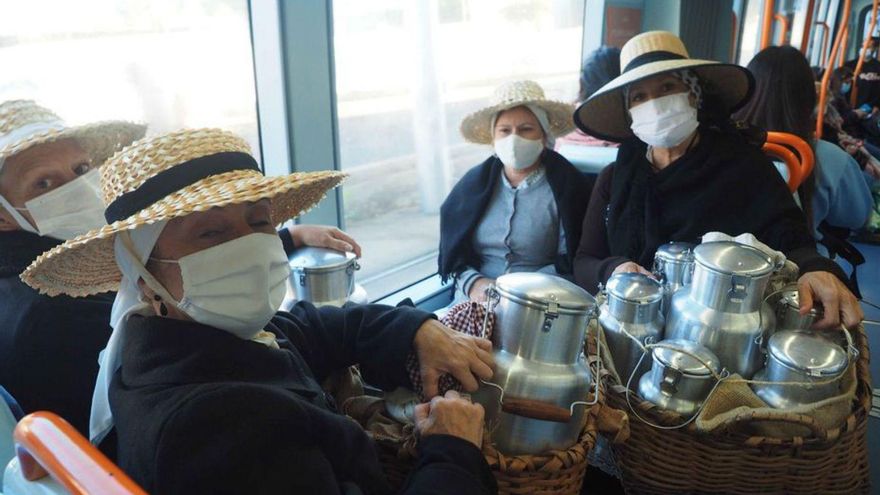
The route between Aguere and the capital of Tenerife, through the unknown rural space that unites them, returns to the present every December 8 thanks to a group of people determined to claim this path as fundamental in the essence of the tradition that the dairy women represent. like few figures.
A group of milkmaids pass in front of an area of terraces in Santa Cruz and cause an impact for their traditional clothing. They continue on their way to the tram stop in Fundación, where they awaken surprise and admiration among the waiting users. Then they share with them the journey to La Laguna, the starting point of the Camino de Las Lecheras. The ancestral route of a lost trade that took these brave women from Aguere to the island’s capital to sell their products. Basket on the head, the containers with the precious liquid and road and blanket.
They are the essence of the eighth edition of this route through the little-known rural areas that link both cities. From La Concepción de La Laguna to La Concepción de Santa Cruz with an important participation of hikers. Also of women dressed as milkmaids to commemorate this humble profession that was still growing for less than a century. People who left an indelible mark on the memory of the Tenerife people to the point that they gave their name to a road. Hardworking, brave and devoted to their family, they got up early every day to do household chores and at dawn they left for the Old Recova de Santa Cruz.
The organization values that “today we are lucky to travel for pleasure unlike them.” In addition, these sources add that “the path did not disappear, like so many others of high historical and ethnographic value, under the misunderstood and stuffed carpet of modernity.”
Those who defend the initiative understand that “it is the responsibility of citizens and our political representatives to maintain the cultural heritage and not lose identity as a people.” In this edition, the route has covered the planned participation limit, both for hikers and volunteers.
From helmet to helmet
The participants traveled through the center of the city of La Laguna to the Plaza del Cristo to then enter the Caminos de La Cañada lagunera, passing through El Bronco, Lomo Largo, Valle de Las Chozas and Valle Hilario until they reached Valle Jiménez. There the milkmaids were waiting to offer them a snack.
In this lagoon neighborhood they were received by José Luís Hernández, Councilor for the Environment, who expressed his “satisfaction” to see “the effort of a group of mountaineers that intends to recover such an emblematic path and also its associated patrimony ». This is reflected in various ethnographic elements. He recalled the desire of the neighbors to build a fountain and some laundries that will help revitalize the neighborhood.
The president of the Insular Mountaineering Federation, Humberto Domínguez, also present at the day, congratulated the hikers and encouraged them to continue practicing a sport that gives so much satisfaction and provides health because it is carried out mainly in nature and often in rural areas to contribute to its economic recovery.
The group of walkers then continued their journey to the Church of La Concepción de Santa Cruz. The route crossed the Las Goteras ravine, Cueva Roja, already in the capital, Barrio Nuevo, La Salud, Salamanca, Duggi and the Puente de El Cabo. It should be remembered that The Camino de las Lecheras was the main and most direct communication route between Los Valles laguneros and Santa Cruz de Tenerife. It probably was since the first years of the 16th century.
This year’s initiative has been possible thanks to the public company MetroTenerife, which manages the tram, for which the organization is grateful, especially its Communications Manager, Santiago Correa. The Cabildo’s Office of Participation and Volunteering, the Sustainable Santa Cruz Foundation, the Santa Cruz de Tenerife City Council, the Environment Department of the La Laguna City Council and the Spanish and Insular Mountaineering Federations have also taken part actively.















